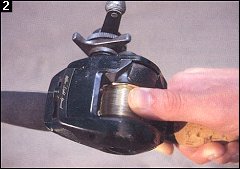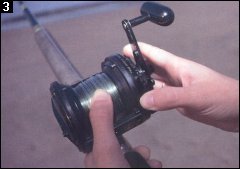Art of Casting - Overhead Reels
Introduction
Overhead-type reels are also very popular, but mostly with serious anglers, prepared to put some time into mastering them. Overhead reels are not slung beneath the rod as is the case with threadlines, but as the name suggests, are mounted on top of the rod.The design of the reel differs too, in that the spool is mounted so that its axle is across the rod.
Overheads include a number of different-sized reels, and each is put to a particular use.The smaller ones used on single-handed rods, are called 'baitcasters' and are popular for throwing moderately weighted baits and lures. Overheads in the next size range up are about the size of a coffee mug and are sometimes referred to as 'surf' or 'boat' reels. Usually, this is about the largest size overhead you can cast with. When you step up in size again to the larger trolling and gamefishing reels, spool weights are such that casting is difficult, if not impossible.To cast with an overhead reel, you have to get the spool revolving, and the larger and heavier the spool is, the greater its inertia.
Some spools are so heavy you couldn't cast the sort of weight that would get them rolling and if you did, you probably couldn't stop it easily either. This highlights the real difficulty in casting with any overhead. Getting an overhead spool rolling is only half the battle. If you don't control how fast, and how long it rolls, it can throw line off in uncontrollable loops.This is called an overrun. Simple overruns are fairly easy to sort out if you take your time and pull line steadily off the reel until you are down to hard-packed line again. But if you don't check an overrun in time, those loose loops build and collide with one another and the reel frame, knotting over each other and burying down into the loosened line load. This is called a backlash - among other, less printable names. Bad backlashes may even have to be cut out, resulting in a good deal of lost time and fishing line, and the probable fraying of your temper. The result is also what is referred to as a "Bird's Nest" - and apt and fitting name.
Casting with Overhead Reels
To cast with an overhead reel, you must first immobilise the spool to prevent it turning, by pressing down on the spool with the thumb of your reel hand. Then, depending on the reel type, you can disengage the gear train by flipping a lever or pressing a button, which puts the reel into free spool.
Now with the spool held in check by the pressure of your thumb, the rod is swung back and then forward again to provide momentum for the casting weight. At the appropriate moment, as the rod is still swinging forward, you lift your thumb from the spool.This allows the casting weight to start the spool rolling and as it flies, line is fed off the spool behind it.
Unlike handlines and threadline reels though, just letting the line go is not the last thing you have to do. Because the line is being pulled from a revolving drum, you have to control how fast and how long that drum spins around. If you don't, it will keep spinning line off, until all the energy of the cast is dissipated.
Long before the spool slows down though, air resistance and gravity will slow the casting weight down. The problem is that these forces do not act as quickly on the reel spool. In fact, as more line is pulled from the spool, its diameter will shrink and the spool will actually accelerate. Left to itself, a ball of tangled line will erupt from the reel and, as a result, you have an instant bird's nest !
To overcome this problem, you have to use the thumb of your reel hand to gently slow the spool so its speed is matched to the flight of the casting weight. This isn't a full-on lock, your thumb need only brush the revolving spool lightly, and, done correctly, this will prevent that fatal acceleration taking place. It's a skill that takes time and practice to master, but depending on aptitude and application; most anglers can learn it quite well. Many others who can't be bothered, turn to threadlines as an easier option.
No wonder they do, casting into a breeze is a common fishing situation, and while it's no problem with a threadline, with an overhead, it definitely is.This is because the wind just provides additional slowing of the casting weight and makes the tendency to overrun even worse. It's not impossible to cast an overhead into the wind, provided you use slim, heavy casting weights, and are very, very careful. Most overhead users also 'punch' their lures or wieghts into the wind, while carefully managing the spin of the spool.
Makers of overhead reels have done what they can to make things easier for would-be users, inventing all sorts of mechanical devices to assist in preventing overrun. Some of these work well, others don't, but none of them is a substitute for developing a smooth casting stroke, a good sense of timing for the release, and what experienced anglers call an 'educated thumb'.
 |  |
| Step 1 Casting with an overhead, whether a surf reel or a baitcaster begins the same way - first you lock the spool with your thumb, then disengage the gear train. Some baitcasters use a full width thumb bar. Others, like the one shown above, have a slide button on one side of the spool. | Step 2 With the gear train disengaged, the only thing preventing the spool revolving and feeding line out is that your thumb is holding it firmly. Make the casting stroke and at the release point, lift your thumb a little, maintaining a light, feathering contact with the revolving spool to prevent overruns. |
 |  |
| Step 3 The surf reel pictured above uses the flip type of lever to disengage the drive gears, so the spool is first locked with the left thumb while the gear lever is flipped back, then the right thumb takes over for the cast as before. Left handed casters will need to allow for that fact. | Step 4 Most surf reels are mounted on two-handed rods and so the non-reel hand once again is used as the pivot point for the cast. |
 |
| Step 5 The above shows just a minor overrun, on how line peels from the spool and begins to bunch up if not controlled. Do not be disheartened by initial problems mastering overhead reels. The skills involved will eventuate with time and practice, and overhead reels are definely great to use, when used with ease and confidence. |
 Fishing Tip : Fishing Tip : |
|
| Why not contact fishSA.com about your Fishing Tip |
|
|